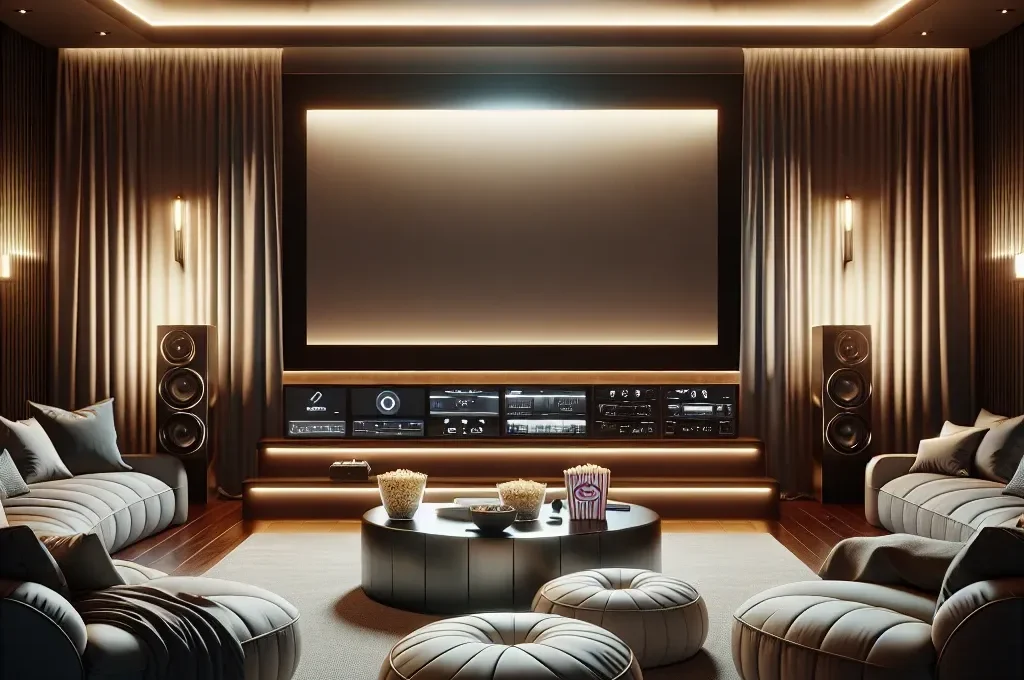Choose the Right Room
When setting up a home theater, the first step is to choose the right room. Ideally, you want a space that can be easily darkened and isolated from outside noise. Basements are often a popular choice because they are naturally dark and quieter.
Select the Best Display
Next, focus on selecting the best display for your home theater. There are several options available:
- Projectors: Ideal for a true cinematic experience, projectors are great for large screens and can deliver high-quality images.
- LED TVs: These offer bright images and rich colors. They are perfect for well-lit rooms and are available in various sizes.
- OLED TVs: Known for their superior image quality, deep blacks, and wide viewing angles, OLED TVs are perfect for an immersive viewing experience.
Audio Matters
A home theater is not complete without a robust audio system. Options to consider include:
- Soundbars: These are compact and easy to set up, making them ideal for smaller spaces.
- Surround Sound Systems: For a more immersive experience, opt for a 5.1 or 7.1 surround sound system, which includes multiple speakers strategically placed around the room.
- Subwoofers: Adding a subwoofer can enhance the bass quality of your system, making action scenes feel more powerful.
Configure the Seating
The seating arrangement plays a crucial role in your home theater experience. Consider the following tips:
- Comfort: Choose recliners or theater-style seating for maximum comfort.
- Distance: Ensure that seats are positioned at the optimal distance from the screen—around 1.5 to 2.5 times the screen diagonal for 1080p displays, and 1 to 1.5 times for 4K screens.
Lighting and Ambiance
Controlling the lighting in your home theater is essential. Here's how to do it:
- Blackout Curtains: Use blackout curtains to block any external light from entering the room.
- Dimmable Lights: Install dimmable lights to control the ambiance and reduce glare from the screen.
Optimize Your Equipment
To get the best performance from your home theater system, follow these optimization tips:
- Calibrate the Display: Use a calibration tool to adjust the brightness, contrast, and color settings of your display for optimal picture quality.
- Position Speakers Correctly: Place your speakers at ear level and at equal distances from your seating area for balanced sound.
- Use High-Quality Cables: Invest in good quality HDMI and audio cables to ensure you get the best signal.
Connectivity and Smart Features
Modern home theaters offer various connectivity options and smart features for a seamless experience:
- Streaming Devices: Use devices like HDMI sticks or set-top boxes to stream content directly to your home theater system.
- Smart Home Integration: Consider integrating your home theater with smart home systems to control everything from a single device.
- Wi-Fi and Ethernet: Ensure your system is connected to the internet either via Wi-Fi or Ethernet for streaming high-definition content.
Maintain Your System
Last but not least, maintaining your home theater system is crucial for its longevity:
- Regular Cleaning: Keep your equipment dust-free to avoid any overheating issues.
- Firmware Updates: Regularly update the firmware of your devices to access the latest features and improvements.
- Check Connections: Periodically check all the connections to ensure everything is functioning correctly.

